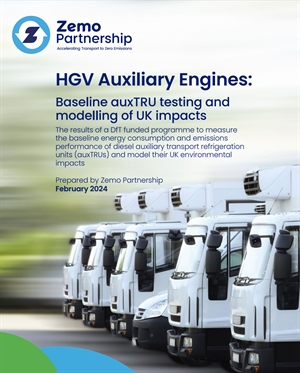Zemo study highlights GHG and polluting emissions from HGVs’ auxiliary transport refrigeration units
Fri 09 February 2024
View all news

(Zemo News Release:) With targets now in place to eliminate tailpipe emissions from all types of road vehicles, and rapid improvements being seen from the latest emission standards like Euro VI, greater attention now needs to be paid to other sources of road (and non-road)-based emissions, such as those from ancillary engines which are used for purposes other than vehicle propulsion.
The impact of these units - commonly found on the trailers pulled by a Euro VI truck - can be as much as double the emissions of oxides of nitrogen (NOx), five times the particulate mass (PM) and up to four hundred times the particle number (PN) compared with emissions from the truck exhaust.
Auxiliary transport refrigeration units (auxTRUs) are considered to be an important source of pollutant emissions, as they represent the largest proportion of ancillary engines used in the road vehicle fleet. However, rigorous emission standards applied to propulsion engines do not currently apply to ancillary engines used in applications such as auxTRUs as these are regarded as non-road mobile machinery (NRMM).
This major work programme - a multi-year project funded by the Department for Transport (DfT) - is a response to the need to understand the UK-wide environmental impact of auxTRUs (and other NRMM). It builds on previous work undertaken between Zemo Partnership and Transport Scotland in 2021.
Zemo’s study, just published, covers results from the first phase of the research, combining test and survey results to provide initial UK-wide estimates of the overall fuel consumption and environmental impacts of diesel auxTRUs.
The results show that UK diesel auxTRUs consume around 235 (range 132-364) million litres of fuel per annum and contribute about 590 (range 330-910) kilo-tonnes of tailpipe GHG emissions. (For comparison, the UK’s freight sector produced total emissions of 21MtCO2e in 2021: link)
The units in operation also produce around 4.4 (2.5-6.9) kilo-tonnes of oxides of nitrogen (NOx) emissions and 126 (71-195) tonnes of particulate matter (PM2.5).
The test results indicate that compared with the vehicle’s Euro VI compliant propulsion engine, a single diesel auxTRU fitted to a Euro VI HGV (in typical city/urban conditions) would:
- Consume around 10% of the fuel (slightly more if made pre-2019).
- Produce about 10% of the GHG emissions (slightly more if made pre-2019).
- Produce at least double (2x) the NOx if pre-2019 and at least 50% more (1.5x) if post-2019.
- Emit at least five times (5x) the particle mass (PM2.5) if pre-2019 and around triple (3x) if post-2019.
- Emit about 400 times (400x) the number of particles if pre-2019 and around 300 times (300x) if post-2019.
The research found that very hot weather will substantially increase the NOx, particle mass, particle number, and fuel consumption of auxTRUs.
Fortunately, many alternative systems for transport refrigeration are now coming to market, (partly driven by the policy changes to 'red diesel’ treatment) including solar powered trailers and electric fridges with zero pollutant emissions in use.
The next stage of the study will extend the work to consider the van sector and investigate the energy and emissions of alternative technologies, to understand what can be done to reduce the environmental impacts of auxTRUs and from other ancillary engine uses such as road sweepers. The final report is due in November 2024.
Zemo research co-author Emily Stevens said: “It’s clear that auxiliary transport refrigeration units and other ancillary engines can significantly add to transport-linked emissions of greenhouse gases as well as those of local pollutants. The level of these emissions can be disproportionately large compared with those from the vehicle’s engine.
“As this study makes clear, there are opportunities for achieving significant emissions reductions in this area. The next stage of our study will identify the most effective ways to achieve these reductions.”
Zemo’s report “HGV Auxiliary Engines: Baseline auxTRU testing and modelling of UK impacts” can be downloaded here.
Related Links
< Back to news list